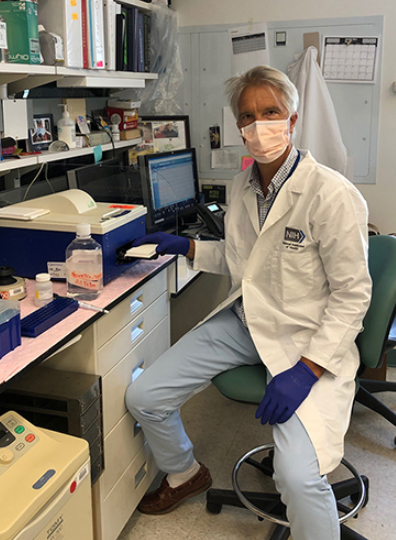Repurposed detection method gives glowing results
As researchers worldwide rushed to tackle the COVID-19 pandemic, NIDCR’s Peter Burbelo, PhD, saw an opportunity to contribute. He realized he could adapt an antibody-detecting method he’d invented 15 years ago and apply it to the study of the novel coronavirus, SARS-CoV-2. Burbelo’s technique, called luciferase immunoprecipitation system (LIPS), has proven useful for detecting antibodies linked to dozens of disorders, including an autoimmune disease that causes dryness of the mouth and eyes, and infectious diseases such as Middle East respiratory syndrome (MERS), which has symptoms similar to COVID-19.
Because the viruses that cause MERS and COVID-19 are closely related, says Burbelo, “I was able to quickly pivot to use LIPS to detect SARS-CoV-2 antibodies.”
Antibodies, the virus-fighting proteins made in response to an infection, can reveal crucial features of SARS-CoV-2 infection within individuals and across populations. Uncovering these details starts with developing assays, or tests, for spotting and precisely measuring antibodies in human samples.
Unlike many other antibody tests, which provide a simple positive/negative result, Burbelo’s highly quantitative assay measures how much antibody is present in a sample based on light emission. Through a “bait-and-bind” mechanism, the test detects SARS-CoV-2 antibodies when the “bait"—laboratory-made viral proteins fused to light-activating enzymes—is added to a solution containing a sample of a person’s serum (a fluid component of blood). If present, the antibody of interest binds to the light-activating bait. The more antibody in a sample, the greater the glow.
Prior to the pandemic, Burbelo had been working with other NIDCR scientists to use LIPS to study Sjögren’s syndrome, an autoimmune disease that causes dry eyes and mouth. He’d also collaborated with other NIH teams to detect antibodies linked to disorders ranging from diabetes to cancer to Lyme disease.
Just weeks after the coronavirus epidemic took hold in the US, Burbelo had developed a LIPS test for SARS-CoV-2 antibodies, and he teamed up with National Institute of Allergy and Infectious Diseases virologist Jeffrey Cohen, MD, to validate the assay by using patient samples. Cohen was able to procure serum from 45 of the country’s earliest COVID-19 patients on the West Coast and at NIH. As a comparison group, the scientists used uninfected serum from 32 people who had donated blood prior to 2018, long before the emergence of COVID-19 in late 2019.
The scientists reported in May in the Journal of Infectious Diseases that the LIPS assay detected antibodies specific to two SARS-CoV-2 proteins—the spike protein and the nucleocapsid protein—with very high sensitivity and specificity, meaning the tests likely detected even trace amounts of antibodies in people with SARS-CoV-2 infection and were unlikely to falsely report the presence of antibodies in people without the infection.
In the context of COVID-19, accurate measurement of antibodies is critical to understanding how immunity develops, how strong it is, and how long it lasts, particularly in people with very mild or asymptomatic infection. Having quantitative details about antibodies will also help researchers evaluate the effectiveness of vaccines.
For the past several months, Burbelo has contributed his LIPS antibody data to many different collaborators to help answer questions about the coronavirus, including infection prevalence, genetic predisposition to infection, and antibody production and stability in certain vulnerable populations.
Burbelo is currently modifying his assay to detect additional SARS-CoV-2 antibodies that may provide insight into viral immunity and severity of SARS-CoV-2 infection. He believes it may be possible to repurpose a rapid form of the assay for easy and widespread use, including point-of-care screening in communities.
“There is much to be understood about the virus, and I’m glad to be able to contribute to the worldwide effort to advance our knowledge of this disease,” says Burbelo.
Related Links
- Sjögren’s Syndrome
- Targeted Approach for Tackling Sjögren’s Syndrome
- Pioneering Gene Therapy for Dry Mouth
References
Sensitivity in Detection of Antibodies to Nucleocapsid and Spike Proteins of Severe Acute Respiratory Syndrome Coronavirus 2 in Patients With Coronavirus Disease 2019. Burbelo PD, Riedo FX, Morishima C, Rawlings S, Smith D, Das S, Strich JR, Chertow DS, Davey RT, Cohen JI. J Infect Dis. 2020 Jun 29;222(2):206-213. doi: 10.1093/infdis/jiaa273.
Profiling Autoantibodies against Salivary Proteins in Sicca Conditions. Burbelo PD, Ferré EMN, Chaturvedi A, Chiorini JA, Alevizos I, Lionakis MS, Warner BM. J Dent Res. 2019 Jul;98(7):772-778. doi: 10.1177/0022034519850564.
Attention Editors
Reprint this article in your own publication or post to your website. NIDCR News articles are not copyrighted. Please acknowledge NIH's National Institute of Dental and Craniofacial Research as the source.
Subscribe to NIDCR Science News
Receive monthly email updates about NIDCR-supported research advances by subscribing to NIDCR Science News.


